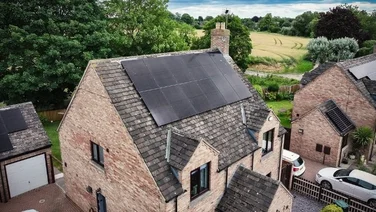- Ripple Energy has two active wind farms – Graig Fatha and Kirkhill Wind Farm
- Whitelaw Brae Wind Farm will save roughly 78,323 tonnes of CO2 annually
- 1st Energy will prioritise Ripple Energy’s three active project sites, including Derril Water Solar Farm

Energy management experts 1st Energy have said they will make sure Ripple Energy’s customers continue to have green energy after buying the financially-troubled energy firm’s wind farms and other assets after the provider went into administration.
Ripple Energy, a Liverpool based company, ran several clean energy projects, including the Graig Fatha and Kirkhill Wind Farms, Whitelaw Brae wind farm, which is still under development, and Derril Water Solar Farm.
1st Energy insisted it would “protect and preserve the community-led structure Ripple pioneered”.
Founded in 2017, Ripple Energy’s goal was to help people save on their energy bills by buying stakes in community-owned energy projects.
Gary Christian, managing director at 1st Energy, said Rippler customers’ supply of green energy will continue “with minimal disruption”.
“It became immediately clear through our conversations with Ripple and their administrators that there was a shared ambition to protect and preserve the community-led structure Ripple pioneered,” Christian explained.
In a statement, 1st Energy has also said that its immediate attention will be directed towards Ripple Energy’s three active project sites – Graig Fatha Windfarm, Kirkhill Wind Farm, Derril Water Solar Farm.
“The Whitelaw Brae site, which is currently under construction, will remain under the control of the administrators, as customers related to this site will receive updates directly from the administrators in due course,” the statement said.
Whitelaw Brae wind farm is located in the Scottish Borders, near Tweedsmuir and north of Moffat, and is ideally located to take advantage of optimal wind exposure.
Once constructed, it will save roughly 78,323 tonnes of CO2 annually. According to Ripple Energy, when running at full power it would take Whitelaw Brae less than three minutes to generate enough electricity to power an average UK home for a whole year.
It was also built to encourage biodiversity with a habitat management plan designed to enhance local ecological resilience, such as a grass maintenance to support nesting wader birds.
Graig Fatha is the UK’s first consumer owned wind farm and is owned by over 900 members. In March 2025 it saved the typical UK household £11.11 in bills and 44kg of CO2, or the equivalent carbon saving of 15 trees.
Kirk Hill, Ripple Energy’s second wind farm, is situated in western Scotland and made up of eight turbines. It can power over 20,000 households and businesses.
It saves 29,667 tonnes of CO2 emissions each year and falls short of Whitelaw Brae by a mere 7 minutes in the time it would take to generate enough electricity to power an average UK household for a year.
As well as wind farms, 1st Energy has also acquired the Derril Water solar farm. Based in Devon, it has 70,000 panels with the potential to power around 14,000 homes, and spans 175 acres. When operation begins in summer 2025, the solar park will save 20,000 tonnes of CO2 emissions each year.







